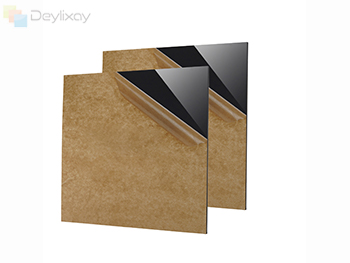Ukucatshangelwa kwe-acrylic sheet njengenye indlela yesimanje yengilazi yendabuko yezicelo zesibuko yisihloko esivela ezimeni ezahlukahlukene, kusukela ezimotweni zokungcebeleka nezindawo zokuzilolonga. Lesi siphakamiso ngokwemvelo siletha isethi yezinzuzo eziphoqayo eceleni kwemikhawulo ethile ehlukile okufanele isetshenziswe ngokucophelela. I-acrylic, i-polymer ebabazekayo eyaziwa ngokumelana nayo nokukhanya okukhanyayo, iletha iphrofayili ehlukile yezinto ezibonakalayo ngokuqhathaniswa nezici ezingaphelelwa yisikhathi zengilazi yesiliva. Ukuhlola ukufaneleka kwayo kudinga ukuhlaziya okusobala kwemvelo ethile lapho isibuko sizosetshenziswa khona, izinto eziza kuqala kumsebenzisi maqondana nokuphepha nokuqina, kanye nokuhweba okwamukelekayo ngokwesikhashana. Ukuqonda ukuthi i-acrylic akuyona indawo yokubuyiselwa okukodwa kepha okuhlukile okusebenzayo ngezimpawu zayo ezihlukile kuyisihluthulelo sokwenza isinqumo esinolwazi esilindelwe ngokulindelwa kobuhle.

Inzuzo ebaluleke kakhulu yokusebenzisa Ishidi le-acrylic ukuze libuyiselwe emuva kwesibuko, futhi imvamisa isizathu esiyinhloko esikhethiwe, yiphrofayili yayo ekhethekile yokuphepha. Ngokungafani nengilazi evusiwe, eyenzelwe ukubhidlizwa ibe yingcezu emincane, engenabungozi, izibuko ezijwayelekile zengilazi zingagaya zibe yingozi enkulu, emilenzeni emibi ebeka engcupheni enkulu yokulimala. I-acrylic, ngokwemvelo yayo uqobo, imelana nomthelela omkhulu kakhulu, inamandla kangaka kunengilazi yobukhulu obufanayo. Ayishwabani; Esikhundleni salokho, kungaqhekeka noma kuqhekeke ngaphansi kwamandla amakhulu, kepha ngokujwayelekile kuzohlala esiqeshini esisodwa, kunciphisa kakhulu ingozi yokulimala. Le mpahla yenza kube ukukhetha okuhle kwezindawo lapho ukuphepha kubaluleke kakhulu, njengasemakamelweni ezingane, lapho ama-slips angenzeka khona, ezikebheni zomphakathi ezibhekise kuzo noma ama-studio omphakathi noma umsebenzi wokudansa lapho imishini yokudansa noma khona kungaholela ekuthomeni ngephutha. Ngaphezu kwalokho, isisindo saso esikhanyayo - cishe isigamu sengilazi - siyinzuzo enkulu esebenzayo. Lesi sici sikwenza lula inqubo yokufaka kakhulu, evame ukuvumela ukunamathela nge-tape enamandla noma kubakaki abalula, ngokungafani nokulungiswa okusindayo okudingekayo ezinkombeni zengilazi ezinzima. Lokhu kukhanya kubuye kwenze kube yindlela ephephile yokufakwa kwesibuko okukhulu kwiminyango noma izindonga lapho isibuko sengilazi esiwayo singakha ingozi enkulu.
Kodwa-ke, ukukhetha ukusebenzisa i-acrylic akuyona ngaphandle kokuyekethisa, futhi okuphawuleka kakhulu kwalawa alele endaweni yokusebenza okubonakalayo nokuqina komhlaba. Isibuko esiseqophelweni eliphezulu seglasi sinikeza ukuboniswa okuyisicaba okuphelele, okungekho emthethweni ngokuxhaswa okujulile, okusilivelekile okuhlala isikhathi eside kakhulu ngaphansi kwezimo ezijwayelekile zokuhlanza. Isibuko se-acrylic, ukuba se-thermoplastic, singaba nokungapheleli okuncane okungokwemvelo futhi sithambekele ekulweni ngokuhamba kwesikhathi, ikakhulukazi uma sifakwe endaweni enkulu ngaphandle kokusekelwa okucashile, okungaholela ekunikezelweni okucashile, okungaholela ekunikezelweni okucashile ekubonisweni. Ukuhlanganiswa okubonakalayo ku-acrylic nakho kusetshenziswe ngendlela ehlukile futhi ngokuvamile kungamanga njengenqubo yesiliva esetshenziswe engilazini. Lokhu kwenza indawo ye-acrylic ibe sengozini enkulu yokuhlahlela. Izihlanza ezi-Abrasive, izindwangu ezinzima, noma ukusula ngolaka zingabeka phansi unomphela, ziyekethise ukuboniswa. Ngakho-ke, ukuhlanza kumele kwenziwe ngokunakekelwa okwedlulele, kusetshenziswa izindwangu ezithambile kuphela, ezingezona ezingezinhle nobumnene, insipho yama-ammonia-mahhala. Okunye ukucatshangelwa okubucayi ukuqina kwesikhathi eside kwezinto ezibonakalayo. Ngenkathi i-acrylic esezingeni eliphakeme imelana nokuphuzi, amamaki aphansi angathambekela ekulahlekelweni kancane kancane kokucaca kanye ne-tint ephuzi lapho kuvezwa ukushiswa ukukhanya kwelanga ngaphezulu kweminyaka eminingi, bekungasobala ukungcolisa ikhwalithi yokuboniswa. Ngokwengeziwe, ukusekela okubonisana kwezinye izibuko ze-acrylic ezisezingeni eliphansi kungadilizwa umswakama uma imiphetho ingavalwanga kahle, okuholela ekuwohlokeni kwesiliva elizungeze umngcele.
Inqubo yokwenza izinqumo, ngakho-ke, izihibe ekuqhathaniseni okuqondile kwalokhu okuhle nokuzithoba ngaphakathi komongo othize wesicelo. Ngokwesibuko sodonga esikhulu, esihlala njalo egumbini lokuhlala elisemthethweni noma egumbini lokugezela lapho ukuphelela kwama-optical kanye nokungaphelelwa isikhathi kufiswa khona, futhi lapho ubungozi bethonya buncane, kuthi ubungozi benkanyezi yendabuko kungenzeka bube yinto ephakeme. Ukubonakaliswa okungenasici okungenasici nokuqina, indawo engamelana nesokungamelana nayo izogcina ukubukeka kwayo kwama-pristine amashumi eminyaka nokunakekelwa okuvamile. Ngakolunye uhlangothi, ngesibuko senzelwe indawo yokuzivocavoca, indawo yokudlala yengane, i-trailer ekhempini, noma igumbi lokushintsha elimatasatasa, izinzuzo zokuphepha nezingokoqobo ze-acrylic ziba zikhonkotha ngokweqile. Ingozi encishisiwe yokuphuka kwenhlekelele kanye nokuphathwa kokuphathwa nokufakwa kuvame ukwedlula ukukhathazeka maqondana nokuphelela okubonakalayo. Kulezi zindawo ezinamandla, okubaluleke kakhulu kuyindlela ebonakalayo, ephephile, futhi eqinile ebonakalayo engamelana nobunzima besikhala, isidingo sokuthi i-acrylic ibekelwe ukufeza. Ekugcineni, ukukhetha akukhona ukuthi iyiphi into engcono kakhulu, kepha iyiphi evumelana kangcono nezimfuno ezithile zesimo. Ngokuhlola ngokweqiniso ukubaluleka kokuphepha, isisindo, ukuthembeka okubonakalayo, kanye nokunakekelwa, umuntu anganquma ukuthi ngabe imvelo yesimanjemanje, eqinile ye-acrylic noma i-classic, ukuboniswa okungenasici kwe-acrylic isixazululo esifanele sezidingo zabo zokubuyiselwa kwezibuko.
 English
English Español
Español Portugues
Portugues Pусский
Pусский Français
Français Deutsch
Deutsch 日本語
日本語 한국어
한국어 العربية
العربية Italiano
Italiano Nederlands
Nederlands Ελληνικά
Ελληνικά Svenska
Svenska Polski
Polski ไทย
ไทย Türk dili
Türk dili हिन्दी
हिन्दी Indonesia
Indonesia Melayu
Melayu Tiếng Việt
Tiếng Việt dansk
dansk Magyar
Magyar қазақ
қазақ বাংলা
বাংলা עִברִית
עִברִית မြန်မာ
မြန်မာ українська
українська norsk
norsk Gaeilge
Gaeilge Română
Română ພາສາລາວ
ພາສາລາວ Filipino
Filipino Suomalainen
Suomalainen slovenský
slovenský o'zbek
o'zbek Igbo
Igbo Hrvatski
Hrvatski Afrikaans isiXhosa
Afrikaans isiXhosa lëtzebuergesch
lëtzebuergesch тоҷикӣ
тоҷикӣ नेपाल
नेपाल Eesti
Eesti Yoruba
Yoruba Монгол
Монгол ខ្មែរ
ខ្មែរ 中文(繁体)
中文(繁体) Afrikaans
Afrikaans












 Ucingo
Ucingo
Phawula
(0)